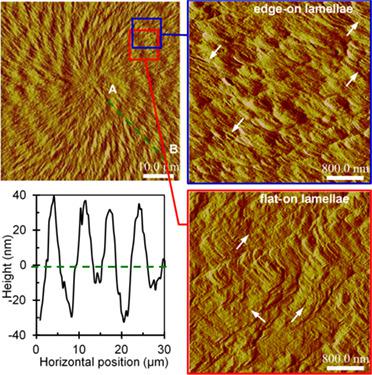当前位置:
X-MOL 学术
›
Polym. Int.
›
论文详情
Our official English website, www.x-mol.net, welcomes your feedback! (Note: you will need to create a separate account there.)
Detailed thermal analysis of crystallization kinetics and band morphology for future blending of absorbable poly(p‐dioxanone) monofilament surgical suture with poly(ε‐caprolactone)
Polymer International ( IF 3.2 ) Pub Date : 2020-10-25 , DOI: 10.1002/pi.6150 Al Mamun 1
Polymer International ( IF 3.2 ) Pub Date : 2020-10-25 , DOI: 10.1002/pi.6150 Al Mamun 1
Affiliation

|
The thermal effects on crystallization kinetics and the band morphology of absorbable poly(p‐dioxanone) (PDS) were studied in detail with TGA, AFM, DSC and polarized optical microscopy techniques. The polymer film was crystallized with isothermal and non‐isothermal conditions over a wide temperature range, cooling from the melt at 140 °C (beyond the equilibrium melting temperature but below the degradation temperature). With the isothermal crystallization process, a well‐defined spherulitic morphology of the PDS polymer, linearly growing in all directions with time, was observed. A microstructure analysis by polarized optical microscopy and AFM revealed that the crystallized PDS shows large spherulites with band morphology, the nucleation density decreases and the spacing between the band increases with crystallization temperature. The periodic band morphology of the spherulites is related to edge‐on and flat‐on lamella orientation. The crystallization temperature dependent spherulite growth rate displayed a bell‐shaped curve, showing a highest spherulite growth rate at 60 °C, explained by classical nucleation theory. These results allowed a good understanding of the thermal and morphological properties of the PDS polymer over a wide temperatures range in both isothermal and non‐isothermal conditions. Additionally, the crystallization and melting behaviors of the PDS polymer were studied and compared for the future application of blending with other compatible polymers, e.g. poly(ε‐caprolactone). © 2020 Society of Industrial Chemistry
中文翻译:

详细的结晶动力学和能带形态的热分析,用于将来可吸收的聚对二氧杂环己酮单丝外科缝合线与聚己内酯的混合
热对可吸收聚(p)结晶动力学和能带形貌的影响使用TGA,AFM,DSC和偏光光学显微镜技术对二恶烷酮(PDS)进行了详细研究。聚合物膜在很宽的温度范围内,等温和非等温条件下结晶,从熔体在140°C(超过平衡熔融温度但低于降解温度)冷却。在等温结晶过程中,观察到了PDS聚合物的良好定义的球状形态,随时间在所有方向上线性增长。偏光显微镜和原子力显微镜的显微结构分析表明,结晶的PDS显示大的球晶具有能带形态,成核密度降低,能带间距随着晶化温度的增加而增大。球晶的周期性谱带形态与边缘上和平坦上的薄片取向有关。依赖于结晶温度的球晶生长速率显示出钟形曲线,在60°C时显示出最高的球晶生长速率,这是经典成核理论所解释的。这些结果使人们对等温和非等温条件下PDS聚合物在较宽温度范围内的热学和形态学特性有了很好的了解。此外,还研究了PDS聚合物的结晶和熔融行为,并将其与其他相容性聚合物(例如聚(ε-己内酯))共混的未来应用进行了比较。©2020工业化学学会 这些结果使人们对等温和非等温条件下PDS聚合物在较宽温度范围内的热学和形态学特性有了很好的了解。此外,还研究了PDS聚合物的结晶和熔融行为,并将其与其他相容性聚合物(例如聚(ε-己内酯))共混的未来应用进行了比较。©2020工业化学学会 这些结果使人们对等温和非等温条件下PDS聚合物在较宽温度范围内的热学和形态学特性有了很好的了解。此外,还研究了PDS聚合物的结晶和熔融行为,并将其与其他相容性聚合物(例如聚(ε-己内酯))共混的未来应用进行了比较。©2020工业化学学会
更新日期:2020-10-25
中文翻译:

详细的结晶动力学和能带形态的热分析,用于将来可吸收的聚对二氧杂环己酮单丝外科缝合线与聚己内酯的混合
热对可吸收聚(p)结晶动力学和能带形貌的影响使用TGA,AFM,DSC和偏光光学显微镜技术对二恶烷酮(PDS)进行了详细研究。聚合物膜在很宽的温度范围内,等温和非等温条件下结晶,从熔体在140°C(超过平衡熔融温度但低于降解温度)冷却。在等温结晶过程中,观察到了PDS聚合物的良好定义的球状形态,随时间在所有方向上线性增长。偏光显微镜和原子力显微镜的显微结构分析表明,结晶的PDS显示大的球晶具有能带形态,成核密度降低,能带间距随着晶化温度的增加而增大。球晶的周期性谱带形态与边缘上和平坦上的薄片取向有关。依赖于结晶温度的球晶生长速率显示出钟形曲线,在60°C时显示出最高的球晶生长速率,这是经典成核理论所解释的。这些结果使人们对等温和非等温条件下PDS聚合物在较宽温度范围内的热学和形态学特性有了很好的了解。此外,还研究了PDS聚合物的结晶和熔融行为,并将其与其他相容性聚合物(例如聚(ε-己内酯))共混的未来应用进行了比较。©2020工业化学学会 这些结果使人们对等温和非等温条件下PDS聚合物在较宽温度范围内的热学和形态学特性有了很好的了解。此外,还研究了PDS聚合物的结晶和熔融行为,并将其与其他相容性聚合物(例如聚(ε-己内酯))共混的未来应用进行了比较。©2020工业化学学会 这些结果使人们对等温和非等温条件下PDS聚合物在较宽温度范围内的热学和形态学特性有了很好的了解。此外,还研究了PDS聚合物的结晶和熔融行为,并将其与其他相容性聚合物(例如聚(ε-己内酯))共混的未来应用进行了比较。©2020工业化学学会



























 京公网安备 11010802027423号
京公网安备 11010802027423号